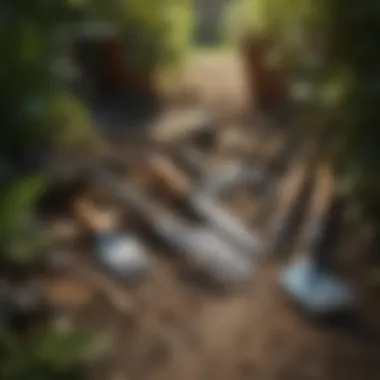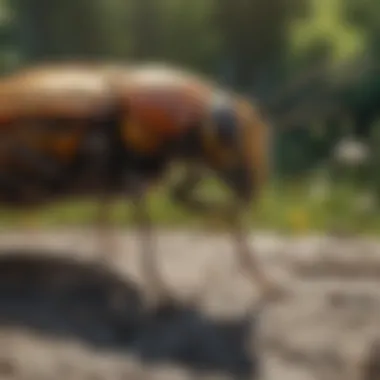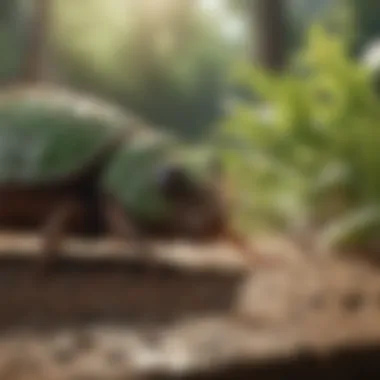Effective Strategies for Outdoor Pest Control


Intro
Outdoor pest control is a significant concern for homeowners and gardeners alike. Pests can cause extensive damage to plants and structures, disrupt the natural ecosystem, and even pose health risks. Understanding effective strategies for managing these pests is crucial in maintaining a healthy living environment. This article outlines several approaches ranging from preventative measures to sustainable solutions.
Understanding Pests
Definition of Pests
Pests are organisms that negatively impact human activities, primarily by causing damage to crops, plants, and property. They can be insects, rodents, or even invasive plant species. Recognizing what constitutes a pest is the first step in managing them effectively.
Importance of Pest Identification
Identifying pests accurately is vital for effective control. Different pests require different management strategies. For example, aphids may need insecticidal soap, while larger pests like rabbits may need fencing. Misidentifying a pest could lead to using inadequate or harmful treatments. Thus, correct identification guides the approach to control methods.
Prevention Techniques
Home and Garden Preventative Measures
Preventing pests is often more effective than trying to control them after an infestation. Here are some proven methods:
- Maintain Cleanliness: Regularly clean outdoor areas and remove debris that may harbor pests.
- Use Barriers: Screens on doors and windows can prevent pests from entering homes.
- Water Management: Ensure proper drainage around plants to avoid creating breeding grounds for mosquitoes.
Seasonal Prevention Tips
Different seasons bring different pest challenges. Adapting your prevention strategies seasonally can be effective:
- Spring: Focus on inspecting and treating early infestations before they spread.
- Summer: Regular monitoring is critical as warm temperatures increase pest activity.
- Fall: Prepare for winter by sealing gaps in structures to prevent rodent entry.
Eco-Friendly Pest Control Solutions
Overview of Sustainable Practices
Eco-friendly pest control emphasizes the use of natural methods that minimize harm to the environment. Integrated Pest Management (IPM) is an approach that combines cultural, mechanical, biological, and chemical tools. It focuses on long-term prevention and reduces reliance on chemical pesticides, promoting sustainability.
Natural Remedies and Their Effectiveness
Many homeowners seek natural remedies to control pests without introducing synthetic chemicals. Some effective natural options are:
- Diatomaceous Earth: A natural powder that can kill insects by dehydrating them.
- Neem Oil: Derived from the neem tree, it can repel various pests and disrupt their reproductive cycles.
- Garlic Spray: Known to deter insects with its strong odor.
"By embracing sustainable practices, one can create a healthier garden that nurtures both plants and the environment."
Understanding Outdoor Pests
In the realm of outdoor pest control, comprehending the various types of pests and their life cycles is crucial. This understanding not only aids in combating infestations but also enhances overall landscape management. The first step to effective pest control lies in identifying outdoor pests, which can range from insects and rodents to weeds and microorganisms. Each type of pest poses unique challenges and requires tailored approaches.
Types of Common Outdoor Pests
Identifying Insects and Rodents
Insects such as ants, beetles, and aphids are commonly found in gardens and yards. Identifying these insects is key to developing an appropriate control strategy. Rodents like mice and rats can also invade outdoor spaces, causing damage to plants and structures. The ability to spot these pests early can prevent larger infestations. Their small size and high reproductive rates are notable traits. However, their rapid breeding can lead to significant property damage if not managed properly.
Recognizing Weeds as Pests


Often overlooked, weeds can severely affect the health of outdoor spaces. Weeds compete with desired plants for nutrients, water, and sunlight. Recognizing the presence of weeds is essential for maintaining a healthy landscape. Key characteristics include their rapid growth and ability to thrive in various conditions. Weeds can choke out other plants, making it vital to apply appropriate control methods to prevent their proliferation in garden areas.
The Impact of Fungi and Bacteria
Fungi and bacteria are often silent threats in outdoor settings. They can cause diseases in plants, leading to wilting or death. Identifying these microorganisms is critical for effective pest management. A well-known example is the fungus that causes powdery mildew, which can spread quickly under certain conditions. Understanding their role within the ecosystem can help in applying effective solutions, yet their complexity may require a deeper level of understanding.
Life Cycles of Outdoor Pests
Understanding Breeding Habits
Knowing the breeding habits of pests can significantly impact control efforts. For example, pests that breed multiple times a year can lead to ongoing problems. Understanding how often a pest reproduces informs the timing of interventions. This specificity is beneficial as it allows for a more strategic approach. A unique feature is that managing breeding cycles can lead to reduced pest populations over time.
Seasonal Variations in Pest Activity
Outdoor pests exhibit different activity levels throughout the seasons. Certain pests become more prominent during warm months, while others may only be an issue in cooler weather. By recognizing seasonal patterns, homeowners can anticipate pest challenges. This knowledge is beneficial as it prepares individuals for active pest periods. The ability to adapt pest control strategies according to seasons maximizes effectiveness.
Indicators of Infestation
One of the most important aspects of pest management is recognizing indicators of infestation. Signs such as droppings, damaged plants, or unusual growth patterns serve as early warning signals. Identifying these indicators can prompt timely action, preventing further damage. Understanding the unique signs associated with different pests is crucial. Being proactive based on these indicators is beneficial as it minimizes reliance on reactive measures.
Establishing Prevention Methods
Establishing prevention methods is a crucial part of any pest management strategy. By focusing on prevention, homeowners and gardeners can reduce the likelihood of pest infestations significantly. This approach helps to create a sustainable environment in which plants can thrive without being threatened by pests. The benefits of prevention include protecting the investment in one’s garden, reducing the need for chemical treatments, and promoting overall plant health. Effective prevention methods not only deter pests but also create an ecological balance in the outdoor environment.
Landscape Design to Deter Pests
Setting up a landscape that naturally discourages pests is an effective intervention. Thoughtful landscape design can make a substantial difference in pest control.
Choosing Pest-Resistant Plants
Choosing pest-resistant plants is key to a successful garden. These plants have natural attributes that help them stand up against specific pests. For example, marigolds are known to repel nematodes, while lavender can deter mosquitoes. By selecting such plants, gardeners minimize the risk of infestation, creating a healthier ecosystem overall. The unique feature of pest-resistant plants is their ability to withstand local pests without requiring additional pesticides. However, it is necessary to research which plants are genuinely pest-resistant in your area, as some may be incorrectly labeled.
Creating Natural Barriers
Creating natural barriers involves using plants or physical structures to shield more vulnerable plants from pests. This can include hedges, mulch, and strategic planting that can disorient pests. One key advantage is that these barriers can also enhance the aesthetics of a garden while serving a functional purpose. Utilizing natural barriers helps lessen the dependency on chemical pesticides, fostering a sustainable environment. Nevertheless, these barriers need regular maintenance to ensure effectiveness, which could require additional effort from the gardener.
Maintaining Plant Health
Maintaining plant health is a foundational prevention strategy. Healthy plants are more resistant to pests and diseases. Essential practices such as regular watering, adequate sunlight, and appropriate spacing can boost plant vitality. Furthermore, consistent monitoring can identify early signs of stress or pest presence. Healthy plants can withstand minor pest pressures, often self-repairing or outgrowing attacks. On the downside, maintaining plant health can be labor-intensive and may require knowledge about specific plant needs.
Proper Waste Management
Proper waste management is vital to repel pests effectively. Managing waste helps prevent attracting unwanted insects or rodents into the garden.
Sealing Garbage Containers
Sealing garbage containers is a primary line of defense against pests. Securely closing bins prevents rodents and insects from accessing food sources. This method is simple yet effective. One distinct advantage is that this action significantly reduces the chances of infestations around the outdoor area. While using proper sealing techniques usually works well, inadequate bins can still attract pests, necessitating regular inspections for effectiveness.
Composting Practices
Composting practices can both enrich the soil and manage waste. When done correctly, composting can deter some pests by creating a diverse ecosystem that supports beneficial organisms. The unique feature of composting is that it recycles organic materials, contributing to soil health. However, it's essential to manage composting to avoid attracting pests. If done improperly, compost can become a breeding ground for unwanted insects. Consider adding materials that discourage pests, like citrus peels or crushed eggshells.
Minimizing Attractants
Minimizing attractants is all about removing elements that can draw pests into the garden. This includes not just food waste but also eliminating standing water and debris that may harbor insects. By keeping the area clean, one can significantly reduce pest attraction. The advantage of this method is its low cost—most actions are straightforward and do not require specialized products. However, it necessitates regular upkeep and vigilance to ensure that the attractants do not inadvertently return.


Pest Control Tools and Techniques
Understanding the right tools and techniques for pest control significantly enhances the effectiveness of your management strategies. These tools allow for targeted interventions that can prevent the establishment and spread of pest populations, thereby protecting your landscape and home. In this section, we will delve into both physical barriers and chemical treatments, emphasizing their unique characteristics, benefits, and practical applications.
Physical Barriers in Pest Control
Using Nets and Screens
Nets and screens provide a physical barrier that can effectively keep pests from reaching plants. These barriers, made from fine mesh, can be draped over crops or placed around garden beds. The primary benefit of using nets and screens is their ability to protect plants without introducing chemicals. This method is particularly popular among organic gardeners. The key characteristic of these tools is their flexibility and adaptability to various garden settings. They can be customized to fit different sizes of plants and growing areas. However, one potential disadvantage is that heavy rain or wind might dislodge them, requiring regular monitoring and adjustment.
Mulching to Suppress Weeds
Mulching is an effective technique to suppress weeds while also retaining soil moisture. Organic materials, such as straw, bark, or grass clippings, are spread over the soil surface. The primary aspect of mulching is its dual function: it not only inhibits the growth of weeds but also enriches the soil as it decomposes. This choice is beneficial for fostering soil health and reducing the need for frequent watering. A unique feature of mulch is its ability to create a habitat for beneficial insects, which can help control pests naturally. Nonetheless, improper mulching, such as using non-decomposed materials, may lead to pest attraction instead of deterrence.
Fencing to Exclude Larger Pests
Fencing is a crucial tool for excluding larger pests such as deer, rabbits, and raccoons from gardens. A well-constructed fence acts as a physical barrier that can effectively deter these animals from entering your outdoor spaces. The key characteristic of fencing is its permanence, providing long-lasting protection without the need for frequent maintenance. It comes in various materials, including wood, metal, or even composites. However, the disadvantage lies in the initial cost and effort required for installation. Additionally, if not built correctly, animals might find ways to bypass the barriers.
Chemical Treatments and Their Application
Selecting Appropriate Pesticides
Choosing the right pesticide is critical for efficient pest control, as it directly influences the effectiveness of your efforts. An appropriate selection considers the specific types of pests you are dealing with, as well as the surrounding environment. The significant aspect of selecting pesticides is the balance between efficacy and safety. Non-toxic options exist that can effectively manage pest populations without harming beneficial insects or the environment. Notably, a unique feature of this process is the increasing availability of targeted pesticides that minimize damage to non-target species. However, over-reliance on chemical treatments can lead to resistance in pest populations, making this choice more complex.
Application Methods and Safety
The methods used to apply pesticides can determine their effectiveness and safety. Proper application ensures that the chemicals reach the target pests while minimizing exposure risks to humans and wildlife. Typical methods include spraying, granules, and baiting systems. Choosing the right method is crucial because it can impact your overall pest control success. One unique feature of modern application methods is their precision, with some tools allowing for targeted spraying. On the downside, misuse can lead to health hazards or environmental contamination, making education and caution essential.
Regulations and Environmental Considerations
Pesticide regulations exist to protect human health and the environment. Understanding these regulations is crucial for compliance and effective pest management. They often stipulate how and where pesticides can be used, ensuring that products do not harm aquatic life or other beneficial organisms. A key characteristic of these regulations is their dynamic nature, adapting based on new research and changes in pest behavior. Awareness of these rules also highlights the ethical responsibility of homeowners to manage pests responsibly. However, the complexity of regulations can sometimes lead to confusion among users, underscoring the importance of thorough research before applying treatments.
Comprehensive understanding of these tools and techniques is vital for effective outdoor pest control. They form the foundation for creating a healthy and sustainable outdoor environment.
Eco-Friendly Pest Control Solutions
Eco-friendly pest control solutions hold significant importance in outdoor pest management. They offer alternatives to conventional methods that may adversely impact ecosystems. These solutions prioritize the health of the environment while addressing pest issues effectively. By utilizing eco-friendly practices, behaviors harmful to non-target species, including beneficial insects and mammals, can be reduced. Additionally, these methods often engage natural processes, promoting biodiversity and sustainability.
Natural Repellents and Deterrents
Natural repellents and deterrents contribute greatly to pest control by using non-toxic ingredients to keep pests at bay. They are not harmful to the environment, making them a popular choice among environmentally conscious homeowners. Essential oils, vinegar, and diatomaceous earth are examples that serve this purpose. They provide a practical approach in a garden or home setting, reducing reliance on synthetic chemicals.
Essential Oils and Their Uses
Essential oils represent a specific aspect of natural repellents. They have strong scents that deter pests. For instance, oils such as peppermint and lavender can effectively repel ants and mosquitoes. The advantage of essential oils is their natural origin, making them a sustainable option for pest control. However, they may require frequent application, especially after rain, which can be a drawback for some individuals.
Homemade Pest Control Recipes
Homemade pest control recipes offer a creative and effective way to manage pests while being cost-effective. Common ingredients like soap, garlic, or hot pepper can be combined to create sprays that disrupt pest activity. The key characteristic of these recipes is affordability, along with the use of common household items. They allow for easy customization to target specific pests. However, their effectiveness can vary, and some recipes may require trial and error to achieve desired results.
Beneficial Insects as Allies
Beneficial insects act as allies in pest control. Introducing or attracting species like ladybugs and lacewings can help manage aphid populations naturally. These insects contribute to the overall health of the garden by preying on unwanted pests. Their key characteristic is natural pest suppression, which reduces the need for chemical applications. The drawback is that beneficial insects need a suitable habitat and food sources, requiring gardeners to understand their needs and lifestyle.
Sustainable Practices in Outdoor Pest Management


Integrating sustainable practices in outdoor pest management is essential for long-term pest control strategies. These practices focus on minimizing environmental impacts while still managing pest populations effectively. Adopting sustainable methods leads to healthier ecosystems and resilient plant growth.
Integrating Pest Management Strategies
Integrating pest management strategies allows for a comprehensive approach to controlling pests while considering economic, environmental, and social factors. This methodology emphasizes monitoring and using a combination of biological, cultural, and mechanical control methods. The key characteristic of this approach is its holistic view, addressing the ecosystem's balance rather than simply eliminating pests. The disadvantage lies in the time and effort required to implement and monitor such strategies, which may discourage some homeowners.
Monitoring and Recording Pest Activity
Monitoring and recording pest activity is critical in effective pest management. Observing when and where pests appear helps in making informed decisions on when to act. This practice leads to timely interventions, potentially minimizing damage. Its significance lies in developing an understanding of pest patterns. The unique feature of this method includes tracking changes over time. However, it can be time-consuming and may require a commitment to regular observations.
Rotating Crops to Disrupt Life Cycles
Rotating crops is a sustainable practice that disrupts pest life cycles by changing the planting location of crops each season. This practice helps prevent the buildup of specific pests and diseases that favor particular plants. The key characteristic is diversification, helping to maintain soil health by avoiding nutrient depletion. One downside could be the potential difficulty in planning crop rotations effectively, especially for inexperienced gardeners.
With eco-friendly and sustainable practices, outdoor pest control can transform into a rewarding endeavor promoting ecological balance and health.
Educating Yourself and Others
Involving community members creates an effective network for sharing information and resources. This approach can reduce the overall pest populations more efficiently than isolated efforts. Sharing knowledge enhances the ability of neighbors to identify problems early and react before pests become a larger issue.
Additionally, an informed community can advocate for sustainable pest management policies. Such engagement can lead to better local regulations that support eco-friendly practices. It is beneficial to have accessible resources that facilitate education and community involvement.
Resources for Pest Control Education
Books and Publications on Pest Management
Books and publications on pest management provide a foundation for understanding various pest control strategies. They often contain in-depth knowledge about the types of pests, their life cycles, and effective methods of control. A key characteristic of such resources is their systematic approach to pest identification and management. They are a popular choice because they offer reliable information backed by research.
One unique feature of these publications is that many are written by experts in the field, ensuring quality content. However, the disadvantage can be the need for a certain level of prior knowledge to fully grasp the technical language sometimes used. These resources are essential for anyone serious about comprehensive pest management.
Online Courses and Tutorials
Online courses and tutorials represent a modern way to educate oneself about pest control. This method allows individuals to learn at their own pace, which is a significant advantage for busy homeowners. The key characteristic of these platforms is their flexibility, allowing users to access material anytime and anywhere.
Online education often includes interactive components, such as quizzes or video demonstrations, enhancing the learning experience. However, one disadvantage is that not all courses may provide qualifications or certifications upon completion, which may matter to some individuals. Overall, such information is a valuable resource for hands-on learning and practical application.
Community Workshops and Events
Community workshops and events offer a practical approach to pest control education. These gatherings enable face-to-face interaction with experts and fellow community members, fostering a collaborative environment. A key characteristic is the hands-on experiences often provided, allowing participants to practice skills they learn in real-world settings.
This direct engagement contributes to a shared understanding of local pest issues and solutions. A potential disadvantage is that these events are limited to scheduled times, which may not accommodate everyone's availability. Nonetheless, they serve as effective platforms to empower individuals with knowledge and actionable strategies.
Engaging the Community in Pest Control Efforts
Sharing Best Practices with Neighbors
Sharing best practices with neighbors is essential for creating a united front against pest populations. It encourages the exchange of successful strategies and insights, leading to a more informed community. The key characteristic of this approach is its focus on collaboration, where everyone can contribute and benefit.
Being in a community that shares pest control knowledge ensures that no single household is left vulnerable to infestations. However, it requires open communication and trust among neighbors, which can sometimes be challenging to establish.
Creating Local Gardening Groups
Creating local gardening groups plays a significant role in educating community members about pest management. These groups serve as platforms to share experiences and techniques for cultivating healthy gardens. A key characteristic is the emphasis on sustainable gardening practices, which help in minimizing pest problems.
Members can share resources such as pest-resistant plants or eco-friendly gardening methods, enhancing the overall health of local ecosystems. A disadvantage may be that not all members may be equally invested in pest control, which could hinder collective efforts.
Advocacy for Sustainable Pest Management Policies
Advocacy for sustainable pest management policies is crucial in shaping local regulations and practices. This involves community members coming together to highlight the importance of eco-friendly pest control methods. A key characteristic of advocacy is the focus on influencing change at a systemic level, which can lead to long-lasting improvements.
Community-driven initiatives often receive more attention from local governments, encouraging the implementation of sustainable practices. However, advocacy may require significant effort and commitment from individuals, and results may take time to manifest. Overall, the impact of collective advocacy can be substantial, aligning community goals with ecological sustainability.



